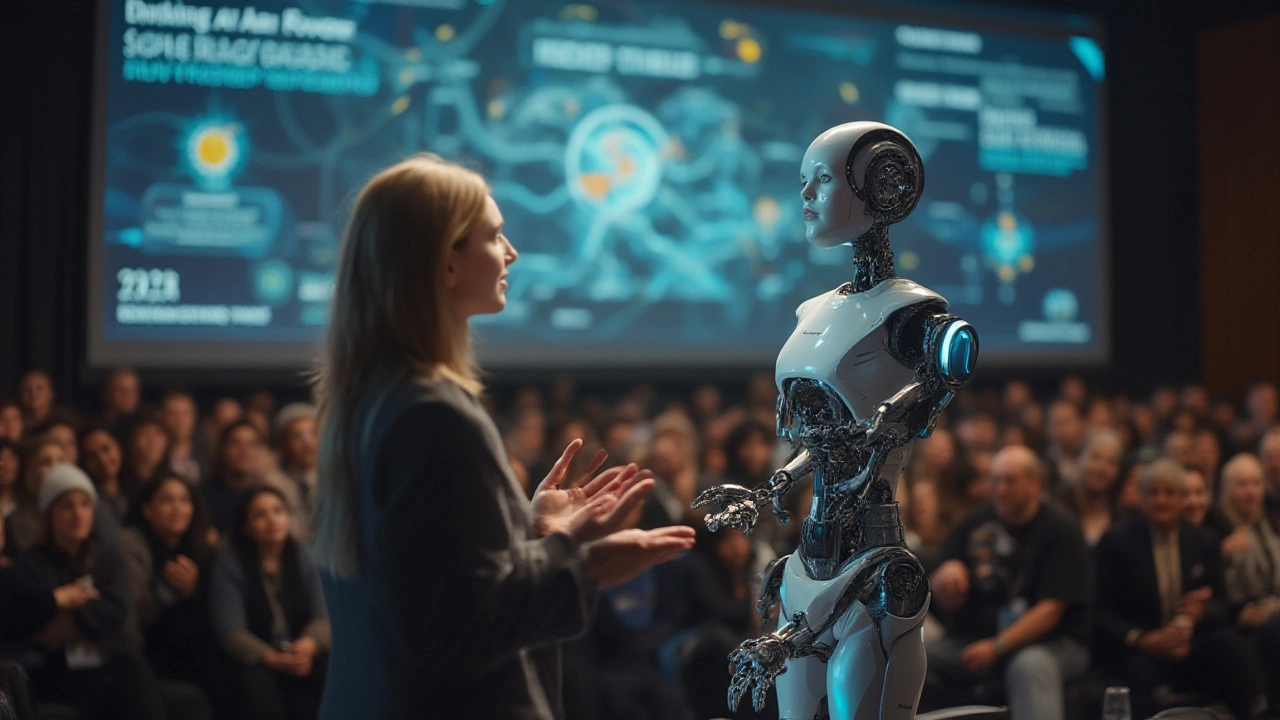Someone just asked me if coding for AI is some distant, science-fiction idea reserved for Silicon Valley types and moody tech geniuses. The truth is way less dramatic—and way more real. AI-powered programs already book your flights, suggest music on your phone, and help doctors spot risky illnesses. It's not some future thing; it's running our world right now, often in ways you don't even notice. But the magic behind all this? Good, old-fashioned code. The language of programming is driving the AI revolution, turning wild algorithms into useful, problem-solving machines that affect everyone, everywhere—from tiny Hobart all the way to bustling Tokyo.
The Basics: How Coding Powers Real-World AI
When you ask your phone's assistant a question or swipe up for movie recommendations, there’s a cascade of code working behind the scenes. At its core, coding for AI isn’t so different from building a website or developing an app. The big leap comes from letting the machine "learn" instead of just following strict rules. People write the code that creates, trains, and tests algorithms—giving software the power to spot patterns and make predictions. With the right training data and well-written code, AI can learn to recognize faces, translate languages, or even write its own poetry (don’t worry, it’s usually bad at the last one—at least, for now).
The big languages in this space aren’t brand-new. Python, with its straightforward syntax and endless libraries (NumPy, TensorFlow, PyTorch), is the reigning king. Java, C++, and R also have big followings. If you check out GitHub, about 87% of top AI projects in the past three years used Python as either the main or support language. Open-source code means you don’t have to start from scratch—just adapt what’s out there.
If you’re wondering how much actual ‘smarts’ goes into these systems, take self-driving cars. Tesla’s autopilot system digests up to 250MB of data per second. That data gets cleaned and shaped by the code, making snap decisions—should I stop at this yellow light or roll through? Stuff like that needs million-line codebases, much of it written, reviewed, and tested by everyday coders (albeit, very smart ones). Cars, banking apps, voice assistants—they’re all built with code and data, not just AI “magic.”
Key Algorithms & Approaches: What AI Coders Really Do
Coding for AI is not just plugging away on a laptop for hours. It’s puzzle-solving, logic mixing, and creative debugging. At the most basic level, coders start by selecting or building a model (think: a math formula that helps a computer answer questions). The real secret sauce isn’t just picking a model but shaping it with training data—feeding it thousands or millions of examples so it learns the difference between a dog and a bagel. Yes, the infamous AI bagel-dog confusion still happens if you feed the code bad data.
Common algorithms include:
- Decision trees: Simple, easy to explain, used for quick sorting and recommendations.
- Neural networks: Loosely inspired by the human brain, these power speech recognition and image analysis.
- Support vector machines: Good for classification (is this spam or not?).
- Reinforcement learning: Software gets rewarded or penalized as it tries stuff, which is how AlphaGo and self-driving cars get smarter.
AI coders spend most of their time ‘tinkering’ with these models. You can’t just plug in an algorithm and hope for the best. Most of the work is in preprocessing data (cleaning, formatting, handling weird outliers), tweaking hyperparameters (settings that change how an algorithm performs), and coding up scripts that test results, over and over. Even Google’s DeepMind team admitted their best people spend about 70% of their hours cleaning data sets and running tests, not building cutting-edge models. Learning to code for AI often means learning to put up with a lot of failed experiments until you stumble on something that works—and then desperately trying to understand why it worked.

AI Coding in the Real World: Examples and Surprising Use Cases
AI is already everywhere—in ways that sometimes sound like science fiction, but actually aren’t. In health care, machine learning programs sift through X-rays in seconds. Google’s AI model caught early signs of diabetic retinopathy in Indian eye clinics, spotting issues that human doctors sometimes missed. In banking, fraud detection systems use extremely rapid, real-time analysis of millions of transactions, flagging risky purchases long before most humans would notice anything weird.
In my hometown of Hobart, coders teamed up with marine biologists to use AI for predicting southern rock lobster migrations. The code blended ocean temperature data and past catch reports—saving the local fishing industry serious money. Factory workers use AI-powered cameras to check bottles for defects ten times faster than a traditional inspection. Even sports has joined in, with AI-powered cricket analysis quietly running beneath the surface, breaking down technique and pitching advice that even coaches sometimes miss.
If you love shopping, recommendation engines are coded masterpieces. Netflix revealed their AI saves them about $1 billion every year by predicting what viewers will watch (and keeping them around). Amazon’s recommendation engine is so crucial that some insiders joke it “grows more valuable every time someone refreshes the page.” All of these systems are built by teams of developers who shape data, test code, and rewrite until every little tweak pays off in smoother user experiences or higher profits.
Learning to Code for AI: Tips, Tricks, and Pathways
You don’t need a PhD or a hoodie with your startup’s logo. Most AI coders actually started with regular software roles and pivoted as tools and tutorials got easier to use. Today, open-source “playgrounds” like Kaggle, Google Colab, and Hugging Face offer hands-on training for free (or close to it). They give you pre-built datasets, starter code, and a community of tinkerers who troubleshoot each other’s rookie mistakes. About 65% of AI engineers self-report learning their skills mostly online, not in a classroom.
Ready to dive in? Here’s a simple pathway:
- Master Python. Just get comfortable reading and writing scripts. Don’t get distracted by fancy math or obscure libraries on day one.
- Experiment with libraries. TensorFlow and PyTorch are the heavyweights, but try scikit-learn or even basic NumPy for data wrangling to begin with.
- Play with existing models. You can copy open-source code and play with your own tweaks. Change hyperparameters and see what happens.
- Contribute to a project. GitHub or Kaggle are packed with real-world projects where newbies are welcome. Reviewing or improving someone else’s code is how most people level up.
- Follow news and research. AI changes fast. Websites like arXiv or Google Scholar, or even YouTube channels like 3Blue1Brown, break down what’s new in a human way.
And a quick reality check: Most coders aren’t building world-ending AI. They’re fine-tuning a supply chain, spotting spam, or fixing up a chatbot—solving little problems one script at a time. Start small, stay curious, ask dumb questions (they’re not dumb), and remember every breakthrough began with a test that failed.

The Big Picture: What AI Coding Means for Tomorrow
Nothing excites and worries people quite like AI. Talk about “robots taking jobs” or “machines smarter than humans” pops up a lot, but the real story is how coding for AI is unlocking a new toolkit for everyone. Old-school coders are adding machine learning to their skill sets just to stay employed. Kids as young as six are learning Python basics on tablets in classrooms. In 2024, IBM reported over 43% of businesses had adopted AI in at least one major workflow—two years before anyone predicted that level of real-world use.
For those looking to future-proof their skills? Learn to code for AI, yes, but also focus on stuff that machines can’t do easily—creative thinking, complex collaboration, designing for messy, real-world humans. In about five years, odds are, almost every app or website will run some type of machine learning under the hood. That means coding for AI isn’t some “special” task anymore. It’s going to be a core part of tech jobs everywhere—whether you’re building smart farm machinery, making better medical tools, or just trying to stop email spam.
Curious how it’s all changing in real time? Take a look at this table—these are real-world 2024 stats that turned heads last year:
| Industry | AI Adoption Rate (%) | Main AI Application |
|---|---|---|
| Healthcare | 41 | Image analysis, diagnostics |
| Retail | 62 | Recommendation systems, inventory |
| Transport | 33 | Route planning, logistics |
| Finance | 67 | Fraud detection, trading |
| Manufacturing | 52 | Predictive maintenance |
The bottom line? Learning coding for AI isn’t just about chasing the coding for AI hype. It’s about building useful tools, solving actual problems, and shaping the next era of how we live and work. Whether you’re a teenager with a laptop or a pro looking to learn something new, now is the time. The future isn’t coming. It’s already here—and it’s written in code.

